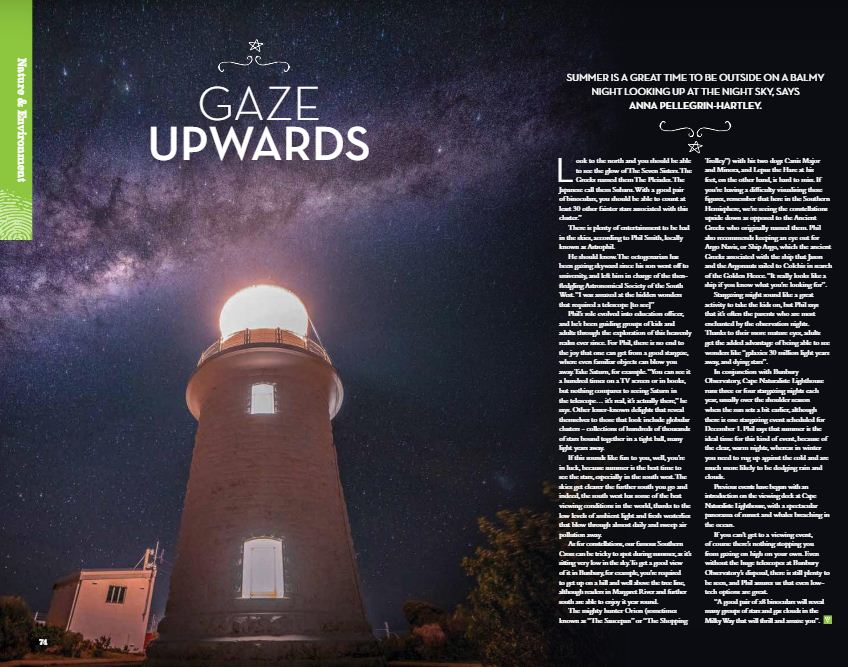Gaze Upwards: Getting Lost Among the Stars in Australia's South-West
/Published in Your Margaret River Region Magazine, November 23, 2018
"Look to the north and you should be able to see the glow of The Seven Sisters. The Greeks named them The Pleiades. The Japanese call them Subaru. With a good pair of binoculars, you should be able to count at least 30 other fainter stars associated with this cluster."
There is plenty of entertainment to be had in the skies, according to Phil Smith, locally known as Astrophil.
He should know. The octogenarian has been gazing skyward since his son went off to university, and left him in charge of the then-fledgling Astronomical Society of the South West. “I was amazed at the hidden wonders that required a telescope [to see]”. Phil’s role evolved into education officer, and he’s been guiding groups of kids and adults through the exploration of this heavenly realm ever since. For Phil, there is no end to the joy that one can get from a good stargaze, where even familiar objects can blow you away. Take Saturn, for example. “You can see it a hundred times on a TV screen or in books, but nothing compares to seeing Saturn in the telescope… it’s real, it’s actually there”. Other lesser-known delights that reveal themselves to those that look include globular clusters - collections of hundreds of thousands of stars bound together in a tight ball, many light years away.
If this sounds like fun to you, well you’re in luck, because rapidly-approaching summer is the best time to see the stars, especially in the south-west. The skies get clearer the further south you go and indeed, the south-west has some of the best viewing conditions in the world, thanks to the low levels of ambient light, and fresh westerlies that blow through almost daily and sweep air pollution away.
As for constellations, our famous Southern Cross can be tricky to spot during summer, as it’s sitting very low in the sky. To get a good view of it in Bunbury, for example, you’re required to get up on a hill and well above the tree line, although readers in Margaret River and further south are able to enjoy it year round.
The mighty hunter Orion (sometimes known as "The Saucepan" or "The Shopping Trolley") with his two dogs Canis Major and Minora, and Lepus the Hare at his feet, on the other hand, is hard to miss. If you’re having a difficulty visualizing these figures, remember that here in the Southern Hemisphere, we’re seeing the constellations upside down as opposed to the Ancient Greeks who originally named them. Phil also recommends keeping an eye out for Argo Navis, or Ship Argo, which the ancient Greeks associated with the ship that Jason and the Argonauts sailed to Colchis in search of the Golden Fleece. “It really looks like a ship if you know what you’re looking for”.
Stargazing might sound like a great activity to take the kids on, but Phil says that it’s often the parents who are most enchanted by the observation nights. Thanks to their more mature eyes, adults get the added advantage of being able to see wonders like “galaxies 30 million light years away, and dying stars”.
In conjunction with Bunbury Observatory, Cape Naturaliste Lighthouse runs about 3 or 4 stargazing nights each year, usually over the shoulder season when the sun sets a bit earlier, although there is one stargazing event scheduled for December 1. Phil says that summer is the ideal time for this kind of event, because of the clear, warm nights, whereas in winter you need to rug up against the cold and are much more likely to be dodging rain and clouds.
Previous events have begun with an introduction on the viewing deck at Cape Naturaliste Lighthouse, with a spectacular panorama of sunset and whales breaching in the ocean.
If you can’t get to a viewing event, of course there’s nothing stopping you from gazing on high on your own. Even without the huge telescopes at Bunbury Observatory’s disposal, there is still plenty to be seen, and Phil assures us that even low-tech options are great.
“A good pair of x8 binoculars will reveal many groups of stars and gas clouds in the Milky Way that will thrill and amaze you”.











